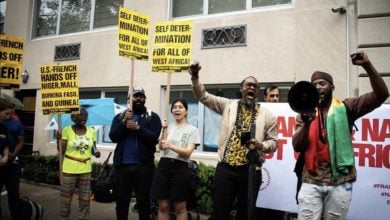This article appeared in March 2007’s Socialism and Liberation magazine. It is based on a Feb. 2 guest presentation at the ANSWER Coalition —Act Now to Stop War and End Racism— office in New York City. Rosca was a political prisoner in the Philippines under the dictatorship of Ferdinand Marcos. She is a leading figure in the GABRIELA Network, a Philippine-U.S. women’s solidarity mass organization.
On Nov. 1, 2005, a 22-year-old Filipina, newly graduated from college, left her home province in Mindanao to celebrate with friends at the tourist area of Olongapo City. Here she encountered six off-duty U.S. Marines who were taking part in the annual joint military exercises between the U.S. military and the Armed Forces of the Philippines.
Olongapo used to be the site of the largest overseas U.S. naval base, the Subic naval base, where submarines,
 A Dec. 4, 2006 protest in Manila demanding U.S. soldiers go to jail for rape. Photo: Hoang Dinhh Nam/AFP/Getty Images |
Hence, Olongapo in due time became notorious for being one of two “sin” cities in the Philippines. The other was Angeles City, former site of Clark Air Base, which used to be the largest U.S. air base overseas.
The facts of the night of Nov. 1, 2005, are simple. Nicole, as she would come to be known, was friendly and trusting, probably because her father worked with the U.S. visiting forces in the Philippines and because she herself was engaged to a Marine captain.
The U.S. Marines plied her with drinks—by witnesses’ accounts, some 15 shots of gin, beer and whatever. When it came time to go, she was so inebriated that Lance Corporal Daniel Smith allegedly had to carry her out piggy-back style to a waiting van.
Now the stories diverge. Two of the marines said they went back to their base. Nicole, they presumed, had gotten out somewhere. The stories diverged about what happened in the van. According to Nicole, she was raped by Smith inside the van while the other three marines hollered, “Go, Smith, go!” The marines claim that there was no rape, only consensual sex.
Witnesses then said that Nicole was dumped out of the van, “like a pig,” half-naked and semi-conscious.
The ensuing investigation, arrest and trial of the four marines lasted over a year, inspiring a continuous battle—not only inside the judicial system but in the media, in the streets and between and among various government agencies and personalities. The Subic Rape Case, as Nicole’s travail has come to be known, resonated far beyond the case’s legal parameters, heightening the already bitter debate over Philippine-U.S. relations, as well as the character of the Philippine government itself and its relations to the U.S. government.
In the end, the Philippine government was revealed as a puppet, a stooge, as a government that disrespected its own judiciary and that shamelessly put a priority on maintaining “good” relations with Washington over justice for and the welfare of its citizens.
Backdrop to the case
Several factors made the Subic Rape Case a seminal case for Filipinos and for U.S.-Philippine relations.
First, it took place in the context of a rape-murder case involving another U.S. Marine in Japan and another rape in South Korea. In both instances, the alleged perpetrators were surrendered to the host government by the U.S. military.
Second, the Subic Rape Case was the first-ever case in 100 years of U.S. occupation of the Philippines—and the only one of 2,000 cases in the post-World War II period—to reach the courts. These prior cases ranged from the shooting death of a boy scavenging in the base’s garbage dump, to the death by blood-poisoning of a 14-year-old girl, when a vibrator wielded by a U.S. soldier broke leaving pieces inside her.
In those cases, the culprits were conveniently shipped out. Witnesses were intimidated and/or bought off. Compensation was offered—in the case of the boy killed in the dump, about a dozen cans of sardines and a sack of rice.
Third, the Subic Rape Case epitomized the 100-year systematic degradation visited upon Filipinas by the U.S. military. This period opened in 1900, when Major Ira Brown of the U.S. occupying forces issued an edict calling for the establishment of houses of “regulated vice”—brothels.
Even though U.S. women’s organizations and women leaders, including Susan B. Anthony, denounced this edict, the practice of using “native” women for military “rest and recreation” persisted and remains to this day.
When Brown issued this edict, the Manila census showed about 10 “working” women in the city, nine of them visitors from Hong Kong. Now, of course, an estimated 800,000 women of the Philippines are engaged in the sex trade, both within and outside the country.
Fourth, the Subic Rape Case underscored the U.S. military’s perspective on women of the Philippines. The Marines, in their testimony, said they thought that Nicole was a “professional.”
Why they would think this way is easy to understand. The U.S. military uses 7,000 Filipinas to serve GIs in Okinawa. During the first Gulf War, rest-and-recreation ships were reportedly floated for the U.S. servicemen, each with 50 women from the Philippines. And right now in Iraq, some 900 Filipinas work at “massage parlors” inside U.S. camps and bases, like Camp Anaconda, under an intricate system of contract and subcontract reportedly traceable to Kellogg, Root and Brown. The women are paid $200 a month.
These factors formed the backdrop for the Subic Rape Case. They explained the intensity with which the people of the Philippines responded to the issue.
The Visiting Forces Agreement
On the other side, the Philippine government, the U.S. embassy and the U.S. military tried to keep the debate restricted to the wordings—not even the spirit—of the Visiting Forces Agreement. The VFA is a nine-page, double-spaced document signed by George Bush I and Joseph Estrada, a deposed Philippine president.
As an executive agreement, the VFA needed no Senate ratification on either side. Such ratification would have been doubtful in the Philippines, since in 1992, the Philippine Senate had voted down any extension of the U.S.-Philippines Military Bases Agreement. GABRIELA, by the way, was the first to serve a notice of eviction of the bases upon the U.S. Embassy in Manila.
The VFA per se is already an outright violation of the Philippine Constitution, which prohibits the presence of foreign troops in the country. In 2001, the current de facto president, Gloria Macapagal-Arroyo, allowed the U.S. military back under the pretext of the “war on terrorism.”
Her argument was that since the U.S. troops would not be in combat situations, there could be no constitutional violation. However, U.S. troops could defend themselves when fired upon—which defied logic, as they wouldn’t be fired upon if they weren’t in the territory.
Since then, the U.S. and Philippine military have held “joint military exercises” annually, so that Filipino soldiers could allegedly become skilled at “combating terrorism.” The number of U.S. military in these joint military exercises has increased—the latest figures show over 5,000 U.S. military troops training some 3,000 Filipino troops.
These annual exercises have raised a number of questions. Why are there more trainers than trainees? Why are the trainees deemed so stupid that training has to be done over and over again? Why would anyone want to be trained by a military that has lost in Vietnam and other places, and is now losing in Iraq?
One consequence of the Philippines’ joining the “war on terror” is that the archipelago is now the fifth-largest recipient of U.S. aid. On the other side of the coin, violence has increased exponentially. Over 800 organizers and activists as well as community, church and union leaders have been assassinated. Eighty women organizers and activists have been assassinated (40 of them from GABRIELA). Blackwater Security has opened training for Filipinos to be deployed to Iraq.
As we know, there are 50,000 mercenaries in Iraq, under contract or subcontract to a strange arrangement between private and official contractors. They actually comprise the second largest occupation force in the country.
Tensions emerge following conviction
When Lance Corporal Smith was found guilty of rape by the court of Judge Benjamin Pozon, it was so unexpected that everyone didn’t quite know how to respond. GABRIELA declared Judge Pozon an “honorary woman.” The Filipino police who took Smith to prison had to scuffle with U.S. Embassy security right inside the courtroom. The Filipino police were visibly delighted by the situation.
U.S. Embassy and Philippine government officials hurriedly signed an agreement saying that custody of errant U.S. military personnel should be with the United States until “all legal proceedings were completed,” including appeals, petitions, injunctions and so on.
For the court to accept such a definition would bring up another provision in the VFA: that “all legal proceedings” have to be completed within a year, otherwise all charges would be moot. When the court refused, the commander of the U.S. Pacific Command—not the U.S. Embassy—announced that all joint military exercises would be canceled until Smith was returned to U.S. custody. He announced further that the U.S. military would cancel all its humanitarian activities in the Philippines.
On Jan. 4, George Bush nominated Adm. William Fallon, who had announced the threat on behalf of the Pacific
 |
With such an overt threat, the government of de facto president Gloria Macapagal-Arroyo—who herself comes from the province of Pampanga where Angeles City and Clark Air Base are located—caved in. On Dec. 29, 2006, in the stupor of the holiday season, Smith was whisked out of a Philippine jail and back to U.S. custody at the embassy by the sea.
Nicole and her lawyers filed one case after another asking the court to declare Smith a fugitive from justice, asking that government officials be cited for contempt of court, asking that Article 5, paragraph 6 of the VFA be declared unconstitutional. Outside, in the streets, women marched, and youth and students marched and clashed with police. The head of the presidential commission on the VFA resigned or was fired, according to the de facto president, for denouncing the decision to return Smith to U.S. custody.
Smith had spent only 30 days in jail.
The joint military exercises resumed in February. The U.S. Pacific Command announced that U.S. Marines will do humanitarian work in the city of Jolo, island of Sulu, in the area of Mindanao, which looks across a very narrow strip of sea to the oilfields of Indonesia and Malaysia.
Why Jolo? After all, the two typhoons that hit the Philippines recently were in Bicol, very much north of Mindanao.
But Jolo is territory of Filipino Muslims. It is close to the Malampaya natural gas reserves, which have been taken over by Texaco, and oil has been discovered under the natural gas. How valuable the Malampaya reserves are can be gleaned from the report that upon its acquisition, Texaco increased its natural gas reserves by 30 percent.
The Malampaya platform, by the way, was built by Halliburton.
There is a ferry that carries Malampaya personnel to a most exclusive resort in Bataan. Among the “luxuries” offered there are women of the Philippines.
Thus goes the unhappy story of Nicole. Thus goes the unhappy story of the women of the Philippines. And thus goes the unhappy story of an archipelago of 7,100 islands whose only fault was that it was too rich in natural resources while its people were too poor, its so-called leaders too weak and too greedy, and its supposedly strongest ally, the United States, too—well, you add the adjectives.





